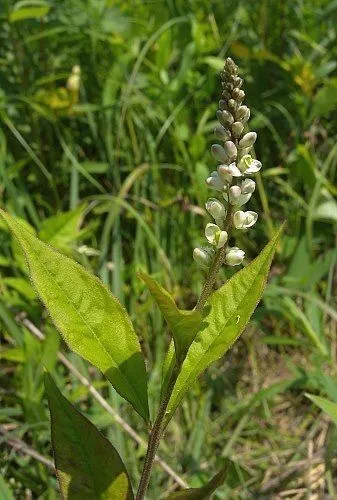
Author: L.
Bibliography: Sp. pl. 2:704. 1753
Year: 1753
Status: accepted
Rank: species
Genus: Polygala
Vegetable: False
Observations: Canada to N. & E. U.S.A.
Seneca snakeroot, scientifically known as Polygala senega, is a fascinating plant native to Canada and the northern and eastern regions of the United States. It belongs to the family Polygalaceae, a distinguished group of plants known for their diverse and often striking characteristics.
Seneca snakeroot has garnered attention for centuries, primarily due to its traditional medicinal uses. The plant was first formally described in 1753, adding a rich historical context to its botanical significance. This history not only underlines its longstanding importance but also provides insights into early botanical exploration and documentation.
This perennial herb is characterized by its small, pea-like flowers, which can range in color but are typically white or pale pink. The flowers form dense terminal spikes, adding a delicate yet prominent feature to the plant’s appearance. The leaves are alternately arranged, slender, and lance-shaped, contributing to the plant’s graceful silhouette.
Polygala senega thrives in a variety of habitats but is most commonly found in prairies, open woodlands, and regions with sandy or rocky soils. Its presence across a broad geographical range highlights its adaptive capabilities and ecological importance in various ecosystems.
One of the most remarkable aspects of Seneca snakeroot is its root system. The roots are thick, twisted, and prominently feature a bitter taste. Historically, these roots were highly valued for their medicinal properties. Indigenous peoples and early settlers utilized Seneca snakeroot to create remedies for respiratory ailments, snake bites, and other health conditions. The root’s efficacy in promoting the expulsion of mucus and relieving symptoms of bronchitis and coughs made it a staple in herbal medicine.
In addition to its medicinal legacy, Seneca snakeroot also plays a role in modern pharmacology. Researchers continue to investigate the chemical compounds found in the plant, such as saponins, which are believed to be responsible for its therapeutic effects. These ongoing studies aim to better understand the plant’s potential benefits and applications in contemporary medicine.
In conclusion, Seneca snakeroot (Polygala senega) is a plant of noteworthy heritage and continued relevance. Its botanical characteristics, ecological presence, and historical significance in traditional medicine and pharmacology underscore its value as a vital component of North American flora.
Eng: seneca snakeroot, senega snakeroot, senega-root, sengaroot, seneca root
Swe: senegarot
Fra: polygale sénéca, polygala sénéga, polygala de sénéca, polygala sénéca, sénéca
En: Seneca snakeroot, Senega snakeroot, Senega-root, Sengaroot, Seneca-Snakeroot, Seneca root
Cr: Miyinsiyikîysa
Fi: Rohtolinnunruoho
Fr: Polygale sénéca, Polygala Sénéga, Polygala de Sénéca, Polygala sénéca, Sénéca
Ka: Სენეგა
Fa: پلیگالا سنگا
Pl: Krzyżownica wirginijska
Sv: Senegarot
Taken Jun 25, 2017 by Emily Robb (cc-by-sa)
Taken Jan 1, 1900 by EOL − Smithsonian Institution, National Museum of Natural History, Department of Botany (cc-by-nc-sa)
Taken Mar 8, 2014 by EOL − Aarongunnar (cc-by-sa)
Taken Jan 1, 1900 by EOL − Smithsonian Institution, National Museum of Natural History, Department of Botany (cc-by-nc-sa)
Taken Jan 1, 1900 by EOL − Gerrit Davidse (cc-by-nc-sa)
Taken Jan 1, 1900 by EOL − Gerrit Davidse (cc-by-nc-sa)
Taken Nov 6, 2018 by Cherokee Twin (cc-by-sa)
Taken Jan 1, 1900 by EOL − John Hilty (cc-by-nc)
Taken Jan 1, 1900 by EOL − Smithsonian Institution, National Museum of Natural History, Department of Botany (cc-by-nc-sa)
Taken Jan 1, 1900 by EOL − Haug, E. (cc-by-nc-sa)
Taken Nov 14, 2013 by EOL − Daniel Carter (cc-by-nc)
Taken Jan 1, 1900 by EOL − John Hilty (cc-by-nc)
Taken Jan 1, 1900 by EOL − Gerrit Davidse (cc-by-nc-sa)
© copyright of the Board of Trustees of the Royal Botanic Gardens, Kew.
Growth habit>: Forb/herb
Family: Myrtaceae Author: (F.Muell.) K.D.Hill & L.A.S.Johnson Bibliography: Telopea 6: 402 (1995) Year: 1995 Status:…
Family: Rubiaceae Author: Pierre ex A.Froehner Bibliography: Notizbl. Bot. Gart. Berlin-Dahlem 1: 237 (1897) Year:…
Family: Sapindaceae Author: Koidz. Bibliography: J. Coll. Sci. Imp. Univ. Tokyo 32(1): 38 (1911) Year:…
Family: Asteraceae Author: A.Gray Bibliography: Pacif. Railr. Rep.: 107 (1857) Year: 1857 Status: accepted Rank:…
Family: Fabaceae Author: Medik. Bibliography: Vorles. Churpfälz. Phys.-Ökon. Ges. 2: 398 (1787) Year: 1787 Status:…
Family: Aspleniaceae Author: (Cav.) Alston Bibliography: Bull. Misc. Inform. Kew 1932: 309 (1932) Year: 1932…